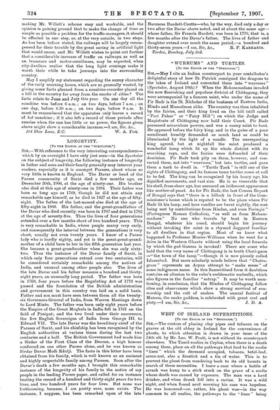" WURRUMS " AND TURTLES.
[To THE EDITOR OF THE "SPECTATOR."] Sin,—May I cite an Indian counterpart to your contributor's delightful story of how St. Patrick consigned the dragons to the lakes of Ireland and converted them into " wurrums " (Spectator, August 10th) ? When the Mohammedans invaded the now flourishing and populous district of Chittagong, they were accompanied by a famous saint, who under the name of Pir Badr is [be St. Nicholas of the boatmen of Eastern India, Hindu and Mussulman alike. The country was then inhabited by the fairies, and their king lived on the bill (still called "Pan i Pahar " or "Fairy Hill") on which the Judge and Magistrate of Chittagong now hold their Court. Pir Badr possessed miraculous powers, and was a canny saint to boot. He appeared before the fairy king, and in the guise of a poor mendicant humbly demanded as much land as could be illuminated by the light of a candle. The unsuspecting king agreed, but at nightfall the saint produced a wonderful lamp which lit up the whole district with its searching rays, and the fairies were defrauded of their dominion. Pir Badr took pity on them, however, and con- verted them, not into " wurrums," but into turtles, and gave them a tank to dwell in. "Turtle Tank" is still one of the sights of Chittagong, and its famous tame turtles come at call to be fed. The king can be recognised by his hoary age, his dignified movements, and vast size. He is so venerable that his shell, from sheer age, has assumed an iridescent appearance like mother-of-pearl. As for Pir Badr, the last Census Report of Bengal says that "there is a hillock in front of the Com- missioner's house which is reputed to be the place where Pir Badr lit his lamp, and here candles are burnt nightly, the cost being met by contributions from Hindus, and even Fering,is" (Portuguese Roman Catholics), "as well as from Mullam- madam." No one who travels by boat in Eastern Bengal, whatever his Creed, should begin his journey without invoking the saint in a rhymed doggerel familiar to all dwellers in that region. Most of us know what happened to Professor Monier-Williams when he went for a drive in the Western Ghauts without using the local formula by which the god Ganesa is invoked! There are some who hold that the very name of Chittagong is in truth Chati-gaon —" the town of the lamp "—though it is now piously called Islamabad. But more scholarly minds believe that " Matra- gram " represents an Aryan attempt to "make sense" of some indigenous name. In this Sanscritised form it doubtless contains an allusion to the ruler's emblematic umbrella, which also figures in the familiar "satrap." It may be worth men- tioning, in conclusion, that the Hindus of Chittagong follow rites and observances which show a strong survival of sun- worship and the cult of snakes. The annual festival of Manasa, the snake goddess, is celebrated with great zeal and






































 Previous page
Previous page